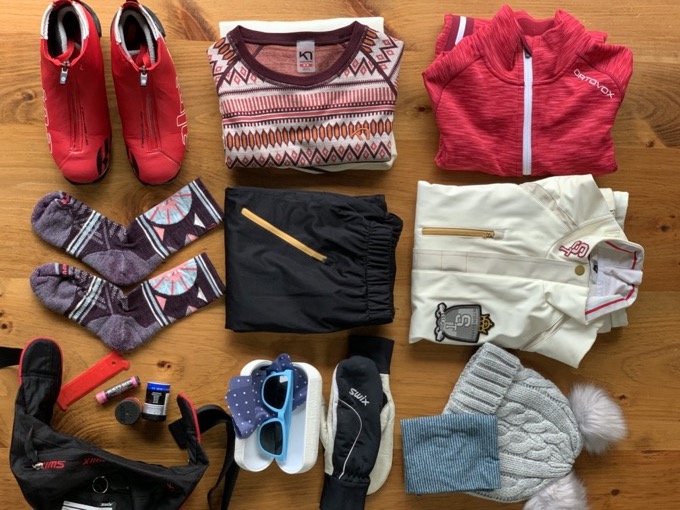
Table of Contents
Dressing for Comfort and Safety
When choosing what to wear cross-country skiing, the important factors to consider are:
- Temperature/forecast,
- Moisture (mostly from sweat, but wet snow or rain are possibilities),
- Wind exposure,
- The features of your planned ski route (e.g. long downhills are cold, trees help block the wind.)
What to expect
- You’ll rapidly warm up and even get sweaty, especially if your route begins with a climb.
- You’ll cool down and chill off whenever you stop.
- Downhills will be cold, especially if your clothing is damp from sweat.
Best strategy
The best clothing strategy for cross-country skiing is the same as for other highly aerobic winter sports.
Dress in layers, with moisture wicking inner layers covered by a windproof outer layer:
- Baselayer
- Midlayer(s)
- Outer Layer
Ideal fabrics
- Are breathable
- Moisture wicking
- Windproof
- Warm even when damp with sweat
- Wool are polyester are both excellent choices
Fabrics to avoid
- Cotton – does not wick moisture well.
- Gore-Tex is not breathable enough for cross-country skiing.
- Down jackets are generally too warm and do not retain heat well if damp.
In a well developed Nordic ski area, with a heated daylodge and lots of people around, the risk to making a bad clothing choice shouldn’t be too serious. You can circle back to your car, perhaps buy something new or even call for help.
When skiing in remote locations, out of contact with others, be more careful about what you wear and what you pack.
Underwear, Baselayers and Midlayers
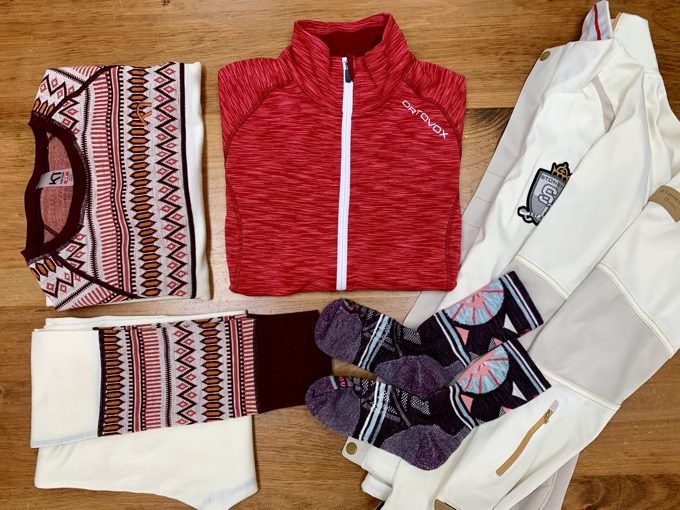
Underwear
Avoid cotton underwear. For extra comfort, look for Windstopper underwear (briefs, bras, long underwear). These are excellent for cold weather but may be too hot on mild days.
Baselayer
The baselayer is worn next to the skin and must be breathable and moisture wicking. It should be close-fitting, so air doesn’t circulate around your body and so the clothing can draw the moisture away from your skin.
Typical fabrics are silk, polyester, wool or polyester-wool blends. Choose a fabric that feels nice against your skin and is warm enough for the conditions of the day. Baselayers are available in different thicknesses for varying warmth. Heavyweight baselayers are for coldest conditions.
Buying Advice: A midweight (medium-warm) baselayer is most versatile. It can be worn with a jacket only, or paired with extra midlayers on cold days.
Midlayer(s)
The midlayer is an optional second (or even third) layer worn between the baselayer and the outer jacket on colder days. Both come in a variety of weights for different temperatures and exertion levels.
Like the baselayer, the fabric must be breathable and moisture wicking. Choose wool or synthetic fabrics. Look for fabrics that offer good insulation without bulk, like a tightly knit merino wool. Fleece jackets work but are overly bulky for skiing.
Feel free to choose from different styles of midlayers. There are lots of choices that work well. You can wear a vest, a pullover sweater, a half zip or full zip light jacket. I prefer a full zip so it’s easy to take off if I overheat.
You probably don’t need two pairs of long underwear on your legs. Most of the time skiers don’t wear a midlayer on the legs. If you find your legs getting cold, try long underwear + tights + windproof cross country ski pants.
Did you know we have instructional cross-country ski videos?
For skiers just getting started:
- Classic vs Skate Skiing: Which is right for you?
- First Day Lesson for Absolute Beginners
- Help for struggling skate skiers: The One Skate Dance Drill
Outer Layer
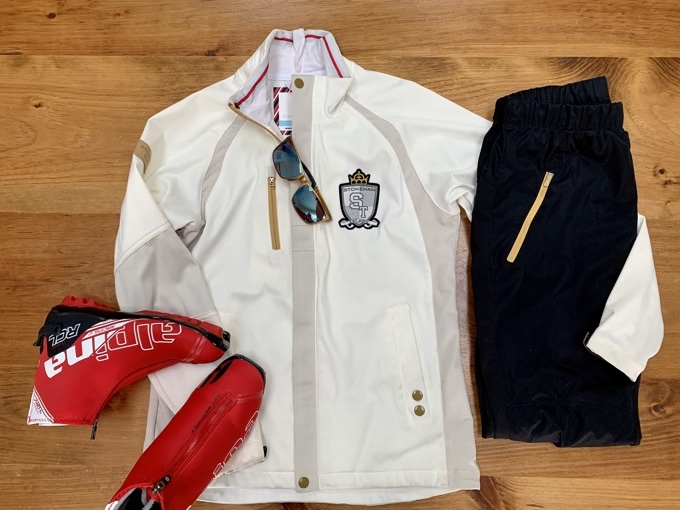
Cross-country ski-specific jackets and pants have special features that you won’t necessarily find in regular winter clothing:
- Stretchy materials – Both skate and classic skiing require fairly large movements with the arms and legs. You need to be able to move freely, unencumbered by your clothes.
- Breathable and Moisture Shedding – You will get sweaty, even on cold days. Always look for breathable materials. Avoid hardshell jackets: Gore-Tex is breathable, but not breathable enough for cross-country skiing. Avoid down jackets, unless it’s extremely cold.
- Windstoper: Ideally your jacket and pants are windproof on the front but not the back of the body. (You only need to protect the front side of the body from wind, as most wind is generated by your forward movement and is most pronounced on the downhills.) Windstopper is a breathable, soft shell material with a wind-proof laminate that provides virtually 100% wind protection. It is used widely in nordic ski-specific clothing and is highly recommended.
Typically the front panels of the jacket and pants are made of Windstopper and the back panels are made of a high stretch, breathable material.
Cross country ski jackets and pants come in different thicknesses or weights. Lightweight coats are for intense training or skiing in mild temperatures.
Midweight jackets are good for most conditions and are the most economical and versatile choice. A midweight outer layer paired with a medium weight base layer and various midlayers is a good combination most of the time.
Clothes you already own
The best clothes are specifically designed for cross-country skiing, but clothes for other high output winter sports also work well.
Winter running and cycling clothes often work well for cross country skiing.
Everyday tights and leggings are not ideal for cross-country skiing as they lack wind protection and usually don’t handle moisture well. They may be OK on a mild day or under a windproof pant.
Downhill skiing jackets and pants are too bulky and warm for nordic skiing. Baselayers from downhill skiing will work for nordic skiing too.
Some nordic ski brands are selling new styles for the lower body: winter tights paired with winter shorts (styled like mountain bike shorts) or a winter skirt for women.
Racing Suits
Competitive skiers race in a heavy gauge Lycra top and bottom worn over their base layer(s). Some skiers train in Lycra as well. It’s very comfortable, but is meant for continuous, high output efforts and would be too cold in many situations.
Accessories
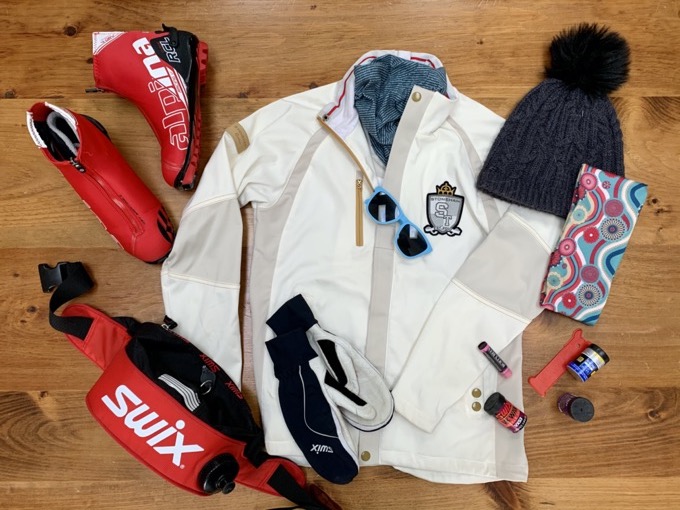
Complete your outfit with:
- Neck Gaiter – usually the lightweight ones are fine, but wool and fleece ones may be called for on cold days.
- Hat or headband. Anything goes. Don’t feel constrained to the typical nordic ski headwear if you don’t like the styling. The same rules apply as for clothing. You want fabrics that block the wind and won’t cause you to overheat.
- Gloves or small mittens. It well worth buying nordic ski-specific handwear as it’s designed to work well in the ski poles.
- Drink Belt
- Sport glasses for protection from the sun and wind are a must.
Packs
Unless you need to pack a lot of things, it’s best to avoid wearing a backpack when cross country skiing. Wear a drink belt or waist pack instead. A backpack throws off your balance and makes it harder to ski with good technique.
On colder days, when skiing in remote locations, or when going for a very long ski, you likely need to carry more gear. In that case, look for a compact, lightweight backpack.
If I was going for a long ski on a cold day and the trip was mostly uphill on the way out and downhill on the way back, I would carry a small backpack with a lightweight jacket, neck gaiter, hat and mitts. At the top of the climb, I’d put the jacket overtop my regular jacket and change out my accessories for the dry ones in my pack.
Solutions for Cold Hands and Feet
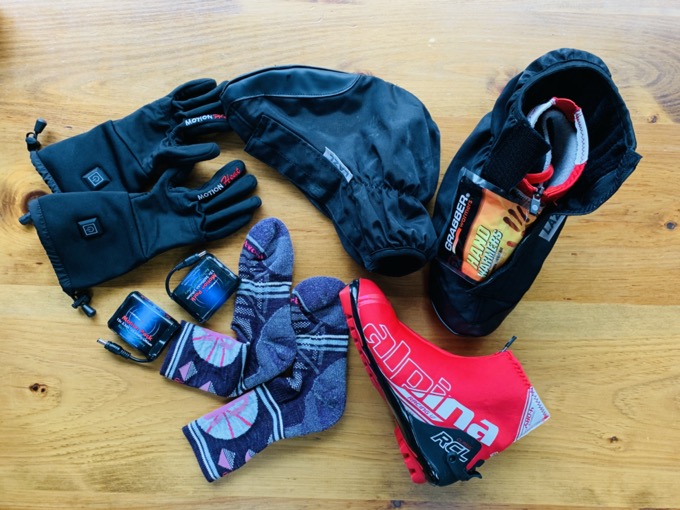
I really struggle with cold hands and feet in the winter. Even when my body is warm my fingers and toes can be icy cold. Here are things that I’ve found helpful (or not):
Cold Feet
- Wear a single pair of midweight socks. Don’t double up or wear very thick socks or you risk getting a blister or cutting off your circulation.
- Toe warmers have never worked for me, I assume it’s because the boot is such a low oxygen environment.
- Change into fresh socks immediately before putting on your ski boots. Even on the drive to the ski trails your feet will get damp. You want your socks as dry as possible when you start out.
- Try an overboot (see photo). These come in two styles: a tight fitting, neoprene boot cover, which is less warm, and a baggy fleece lined Gore-Tex version, which is the warmer option. The fleece-lined Gore-Tex are the ones I have and are in the photo above.
The downside of the overboot is that is can make it harder to put your skis on. As you walk to the start of the trail, snow may get jammed between the boot and overboot, clogging up the binding clip on the base of the boot. It’s awkward, but worth the hassle if you suffer cold feet. (Use the tip of your ski pole to clean out the snow from the bottom of the boot.)
One foolproof solution for cold feet: tuck a handwarmer between the top of the boot and the overboot. But beware: the handwarmer will discolour the boot because it’s basically burning the top of the boot. I’m OK with that because I can replace my boots more easily than my toes. I’ve done this for years. It’s ruined more than one pair of boots but has afforded me many, many hours of enjoyment and healthy exercise.
Cold Hands
In cross-country skiing we use our arms and legs to move forward, so the fit of your gloves and the connection between your hands and your poles is as important as the fit of your boots.
Cross-country ski poles have a harness-style strap that helps position the poles in the hands. (Don’t buy poles with a loop strap if you want to be at all serious about this sport.)
The strap works best with gloves or small, nordic skiing mitts. Things need to be tight fitting and streamlined, not bulky, which limits your options for wearing warm mittens.
The harness strap on the poles comes in different sizes, so you’ll want to buy poles with a strap that fits over your mitts or gloves. If you want to wear thicker gloves, you’ll want a larger sized harness.
Handwarmers can help with cold hands but aren’t perfect. My thumbs still get very cold.
Electric Gloves and Insoles
Lately I’ve been using heated gloves and insoles from this company: Power in Motion (Nordic Ski Lab members enjoy a discount. Another great reason to join us. If you are a member, check out the Special Offers page for the coupon code.)
Again, it’s not a perfect solution as you have to wear an over-mitt, so you still have the problem of extra bulk around the wrists and hands. However, the gloves have been a game changer for me. I’m newer to using the insoles and haven’t determined all the pros and cons yet.
First Aid
Cross-country skiing encompasses many sub-sports, including back-country skiing, ski mountaineering and telemark skiing, which are not topics covered by this website.
Here at Nordic Ski Lab we use videos to teach competition-style skate and classic cross-country skiing.
Classic and skate cross-country skiers like to travel light and fast and the risks are relatively low. Depending on the situation, you may or may not need a first aid kit.
To evaluate the risk, consider:
- Temperature and weather forecast
- Access to a heated building or other shelter, at the parking lot and/or on the trails
- Cell phone coverage
- First aid kit on site.
- Remote locations?
- Number of other people on trails
- Access to rescue.
- Abilities and health of your group members
You’ll need to use your discretion, understand the risks, and think about the area where you are skiing.
If you’re staying relatively near a heated daylodge, there are plenty of other people around, there’s first aid staff on site and you have full cell phone coverage, the risk is low. Most skiers would not carry a first aid kit in this situation.
In a remote location, on a cold day the risks are much higher and include:
- Getting lost
- Severe weather changes
- You have an unexpected medical emergency
- You fall, getting a concussion or hurting yourself in other ways
- Your equipment breaks
If you’re sweaty and have to slow down or stop, you can get into trouble very quickly. You’re dressed for relatively intense movement, not standing around.
When the risk is high, I carry a backpack with:
- Basic first aid supplies
- Emergency shelter (Bothy Bag)
- Extra jacket, hat and thick mitts,
- Hand warmers
- A source of heat
- A space blanket
- A rescue beacon (Spot)
- Duct tape (for equipment repairs)
- A whistle
Après Ski
Unless you ski directly from your house or live just a short drive from your ski area, you may want to change into dry clothes after you ski. I always do.
Pack a small bag with a change of clothes to leave in your car. Don’t forget to include socks and underwear. You’ll want to strip off your damp clothes, all the way down to your birthday suit.
What to wear on your first day
Most first-time skiers overdress and are shedding layers before they are even done their first kilometer. If you are unsure how warm you’ll get, go for a jog or run from your house, wearing your ski clothing to get a sense of what you need to stay comfortable at various temperatures.
Plan to be a little chilly as you start out. If you’re toasty warm as you step onto the trail, you’ll likely be too hot very soon, especially if you have to climb a hill right away.
Consider where you are skiing. If you are taking a lesson and will be spending all your time in the stadium (open flat area by the daylodge) it will probably be colder.
There may not be many trees around to protect you from the wind and you won’t be moving as much if you are listening to an instructor and doing drills.
If you start in an open windy area but soon enter the trees, you’ll find it much warmer once you are out of the wind. If you overdressed and aren’t too far out, go back and change your outfit. It will be more fun if you don’t feel too hot or too cold.
As you get more experience skiing in a range of temperatures and conditions, you’ll find it easier to make the right clothing choices every time.


